SEE RIGHT SIDE BAR.
A Guided Tour: One of the travelers spent a fall semester several years ago studying in Athens. So the three travelers embarked on a journey to her old school. We walked through Plakka, through Hadrian's Arch and the Temple of Zeus. This temple was well preserved for a Greek ruin. Many of the columns stood tall.
The Arch of Hadrian
The Arch of Hadrian was built to celebrate the completion of the temple. This arch is thought by some to represent the dividing line between the ancient Greek city of Athens and Hadrian's new Roman city.
TEMPLE OF ZEUS
This temple is the largest in ancient Greece. The building of this temple was begun in 6th century BC and finished seven hundred years later by the Romans. It was three hundred sixty feet long and one hundred forty-five feet wide. It had one hundred four columns. Only fifteen of which stand today. One of the remaining standing columns was toppled by a storm in 1852. The temple once housed a huge statue of Zeus and an equally colossal statue of the Roman emperor Hadrian.
From the Temple of Zeus one can catch views of the Parthenon and Leviticus hill. From here the travelers walked to the 1896 Olympic stadium. The site was awesome and inspiring to see both the olympic flag and the flag of Greece flying high.
1896 OLYMPIC STADIUM
PANATHENAIC
This stadium was built in the 4th century BC to host the Panathenaic Games. It was rebuilt by the Romans in the second century AD then restored to its Roman condition for the first modern Olympics in 1896. It saw Olympic action again in 2004 when it was the finish for the marathon. The stadium is built of Pentelic marble. The same marble that was used in the Parthenon. It holds eighty thousand people.
We continued our walking tour up a hill to see the school where one traveler spent several months. As we reached the top a gentleman rounded the corner. This man was her teacher through her schooling journey. We were introduced and the professor and the traveler had a short walk back in time. We went on to eat a gyro in the square where the student now traveler studied while abroad then on to see the apartment where she'd lived. We ate gyros and rested then walked down the hill.
Next we strolled through the National Gardens of Greece and onto the Parliament Building where the changing of the guards takes place every hour.
CHANGING OF THE GUARDS
Friday, Saturday and Sunday have been the most touristy of all. So many people walked up and down the streets. When we've stopped for coffee the vendors take this time to sell their wares: hand held sewing machines, flowers, CD's, and so much more. They know tourists tended to be persistent. Ohei (sp) in 'no' in the Greek language. It does help to put a little force in the single word. One can also ignore them. They do tend to go away after a minute or two.
The flag of Greece is blue and white and was officially adopted on December 22, 1978.
The Greek flag has nine horizontal blue and white stripes, with a white cross on a blue square field in the canton position (upper left corner by the flagpole). The white cross symbolizes Greek Orthodoxy, the established religion of Greece. The ratio of its height to its width is 2:3.
The blue and white colors represent the seas surrounding Greece with its blue water and white wave crests.
Recipe of the Day: Baklava
This is a favorite Greek desert but it is very sweet so a little goes a long way. Personally I really like this treat.

Basic Information
Prep Time: 30 min to 1 hour
Cook Time: 30 min to 1 hour
Serves: 8+ people
Ingredients:
For the Filling
2 cups (8 oz) finely chopped almonds
1 cup (4 oz) finely chopped walnuts
1/4 cup (2 oz ) caster (superfine) sugar
2-3 tbsp bread crumbs (optional. It helps to bind the filling. I dint use it in this recipe. I came to know of this trick later)
2 tsp ground cinnamon
1/8 tsp ground cloves
For the syrup
2 cups (1 lb) sugar
2 cups (16 fl oz) water
1 stick cinnamon
1 tbsp lemon juice
For the cover
12 oz packet filo pastry (375g) (see how to make Phyllo dough from scratch here)
Method
1
Place all the ingredients under 'filling' in a bowl.

2
Combine until blended. Meanwhile place all the ingredients for the syrup together in a saucepan and bring it to a bowl, while stirring for the sugar to dissolve. Simmer for 10 minutes and leave it to cool.
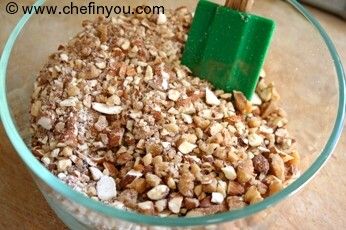
3
Brush a 12X10 in baking dish with butter. Brush 10 sheets of filo with melted butter.
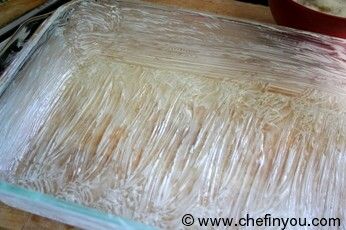
4
Lay them on the dish one by one.
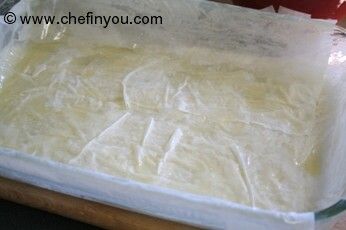
5
Spread the filling in the dish.

6
Now top it off with further 10-12 sheets of pastry, buttering each sheet as needed. You can trim off the excess pastry hanging on the side of your baking dish. Now brush the top of the pastry with more butter.
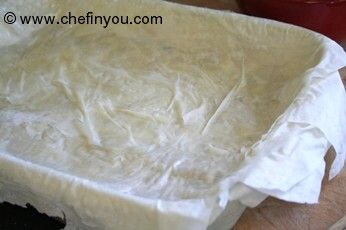
7
With a sharp knife, score the top layers in large diamond shapes.
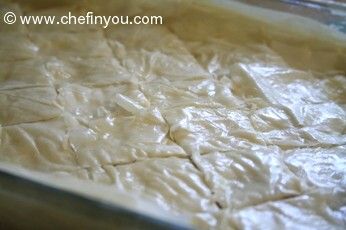
8
Bake in a preheated 160C (325F) oven for 1 hour or until the top turns golden brown. If you find that the top is turning color too quickly, then cover the top with foil.

9
Remove from the oven and slowly pour the syrup over the top.

10
Now comes the MOST DIFFICULT part. You have gotta to let it sit for at least 5-6 hours for it to absorb the syrup.
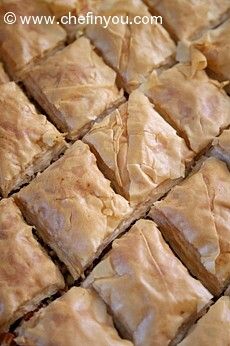
Since I found that impossible, I cut myself few pieces. This is how it looks after 1 hour of soaking ( clearly its not enough!)






2 comments:
The National Gardens look lovely. I also like Baklava. We made it for Christmas one year. That was fun.
thanks, Rosemary. I'm the only one in my family who likes it. I don't even think Relis does.
Post a Comment